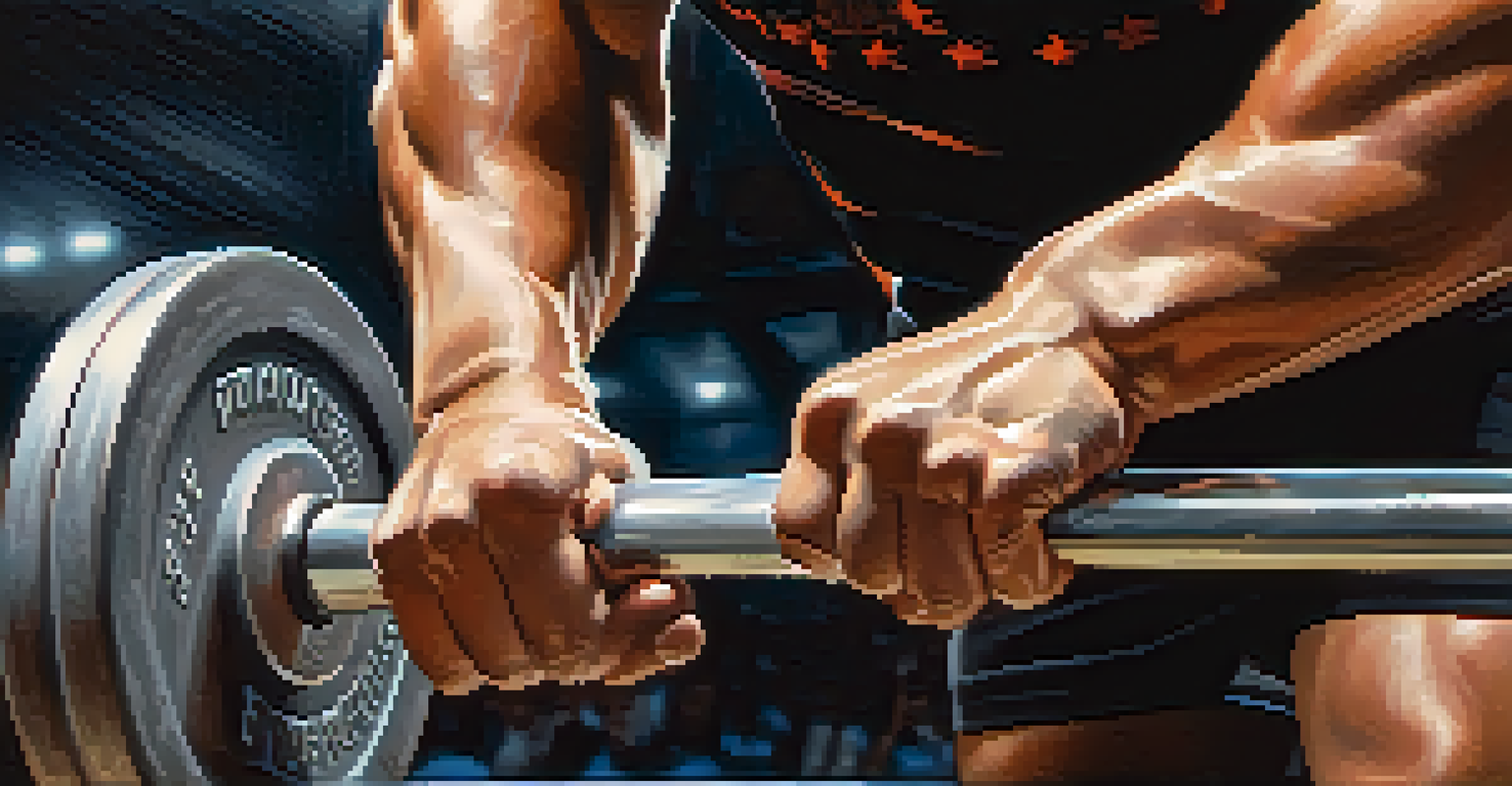Introduction to Powerlifting for Youth: Basics and Benefits

What is Powerlifting? A Youth-Friendly Overview
Powerlifting is a strength sport that focuses on three main lifts: the squat, bench press, and deadlift. Each lift tests different muscle groups, providing a comprehensive workout for the entire body. For youth, powerlifting is not just about lifting heavy weights; it’s about building strength, discipline, and confidence.
Strength does not come from physical capacity. It comes from an indomitable will.
Unlike bodybuilding, which emphasizes muscle size and aesthetics, powerlifting centers around maximum strength. This means young athletes can engage in a competitive yet supportive environment where they can achieve personal bests. The goal is to lift the heaviest weight possible in each of the three lifts, showcasing raw strength rather than appearance.
As a beginner, youth can start with lighter weights and focus on form and technique. This foundational approach not only prevents injuries but also sets the stage for future progress. Powerlifting can be incredibly rewarding for young athletes looking to develop their physical capabilities.
The Key Benefits of Powerlifting for Young Athletes
One of the most significant benefits of powerlifting for youth is the boost in overall strength. Strength training helps young athletes improve their performance in other sports, whether it's football, basketball, or track. Increased strength can translate into better speed, agility, and endurance, making them more competitive.

Moreover, powerlifting encourages discipline and goal-setting. Training for specific lifts requires consistent practice and dedication, teaching youth the value of hard work. Setting and achieving personal goals in powerlifting can also enhance their self-esteem and confidence, which are vital life skills.
Powerlifting Builds Youth Strength
Powerlifting enhances overall strength, benefiting performance in various sports and promoting physical fitness among young athletes.
Additionally, participating in powerlifting can foster a sense of community. Youth often train in groups or teams, providing social interaction and support. This camaraderie can create lasting friendships and a positive environment where athletes motivate each other to push their limits.
Safety First: Powerlifting for Youth Guidelines
Safety is paramount when introducing youth to powerlifting. It’s crucial to start with proper technique and form before adding heavier weights. Young athletes should ideally work with a knowledgeable coach who can guide them through the basics and ensure they are lifting safely.
The only way to prove you are a good sport is to lose.
Warming up is another essential component of a safe training routine. Dynamic stretches and lighter lifts prepare the muscles and joints for more intense activity, reducing the risk of injury. Youth should also be encouraged to listen to their bodies and rest when needed to avoid overtraining.
Finally, using appropriate equipment, such as weightlifting shoes and belts, can enhance safety and performance. These tools help maintain proper posture and support the body during lifts. Establishing a culture of safety in powerlifting is vital for young athletes to thrive and enjoy the sport.
Getting Started: Powerlifting Programs for Youth
Many gyms and fitness centers offer structured powerlifting programs designed specifically for youth. These programs often include age-appropriate training regimens that emphasize strength development while ensuring safety. Beginners typically start with basic techniques before progressing to more complex lifts.
In addition to formal programs, online resources can be valuable. Numerous websites and videos provide instructional content that can help youth learn proper techniques at home. However, it's essential to ensure that any online source is reputable and aligns with safe practices.
Mental Resilience Through Lifting
Engaging in powerlifting helps youth develop mental toughness, improving their concentration, discipline, and self-confidence.
Lastly, local powerlifting clubs and competitions can offer motivation and experience. Participating in events allows young athletes to meet peers, learn from experienced lifters, and test their skills in a friendly competitive environment. Engaging in a community can significantly enhance their powerlifting journey.
Nutrition: Fueling Youth Powerlifters for Success
Nutrition plays a critical role in an athlete's performance, especially for young powerlifters. A balanced diet rich in protein, carbohydrates, and healthy fats provides the necessary energy for training and recovery. Foods like lean meats, whole grains, fruits, and vegetables should be staples in their diet.
Hydration is equally important. Young athletes should drink plenty of water before, during, and after workouts to maintain optimal performance. Dehydration can lead to fatigue and decreased strength, so encouraging regular fluid intake is essential.
Lastly, educating youth on the importance of nutrition can foster healthy habits that last a lifetime. Understanding how food impacts their performance not only boosts their powerlifting but also supports their overall well-being, creating a foundation for a healthy lifestyle.
Mental Strength: The Psychological Benefits of Powerlifting
Powerlifting isn’t just about physical strength; it also builds mental resilience. Young athletes learn to face challenges head-on, whether it's overcoming a tough lift or dealing with competition pressure. These mental skills can translate into other areas of life, helping them navigate academic and social situations.
Moreover, the focus required during training helps improve concentration and discipline. Young powerlifters must concentrate on their form and technique, which can enhance their ability to focus in school and other activities. This discipline fosters a strong work ethic that can benefit them in all aspects of life.
Safe Practices Ensure Enjoyment
Prioritizing safety with proper technique, warm-ups, and appropriate equipment is crucial for young athletes to thrive in powerlifting.
Finally, the sense of accomplishment that comes from achieving personal goals in powerlifting can boost mental health. Celebrating small victories builds confidence and reinforces a positive self-image, which is especially important during the formative years of youth.
The Future of Powerlifting: Trends and Opportunities for Youth
As powerlifting continues to gain popularity, more youth-friendly opportunities are emerging. Schools and community programs are beginning to incorporate powerlifting into their physical education curriculums. This trend not only promotes strength training but also encourages lifelong fitness habits among young people.
With the rise of social media, youth are exposed to powerlifting role models who inspire them to participate. Many young athletes share their journeys online, creating a supportive community that motivates others to try powerlifting. This visibility can help normalize strength training for youth.

Looking ahead, increased accessibility to competitions and training programs will likely make powerlifting an even more viable option for youth. As more facilities cater to young athletes, the future of powerlifting looks bright, paving the way for a new generation of strong and confident individuals.